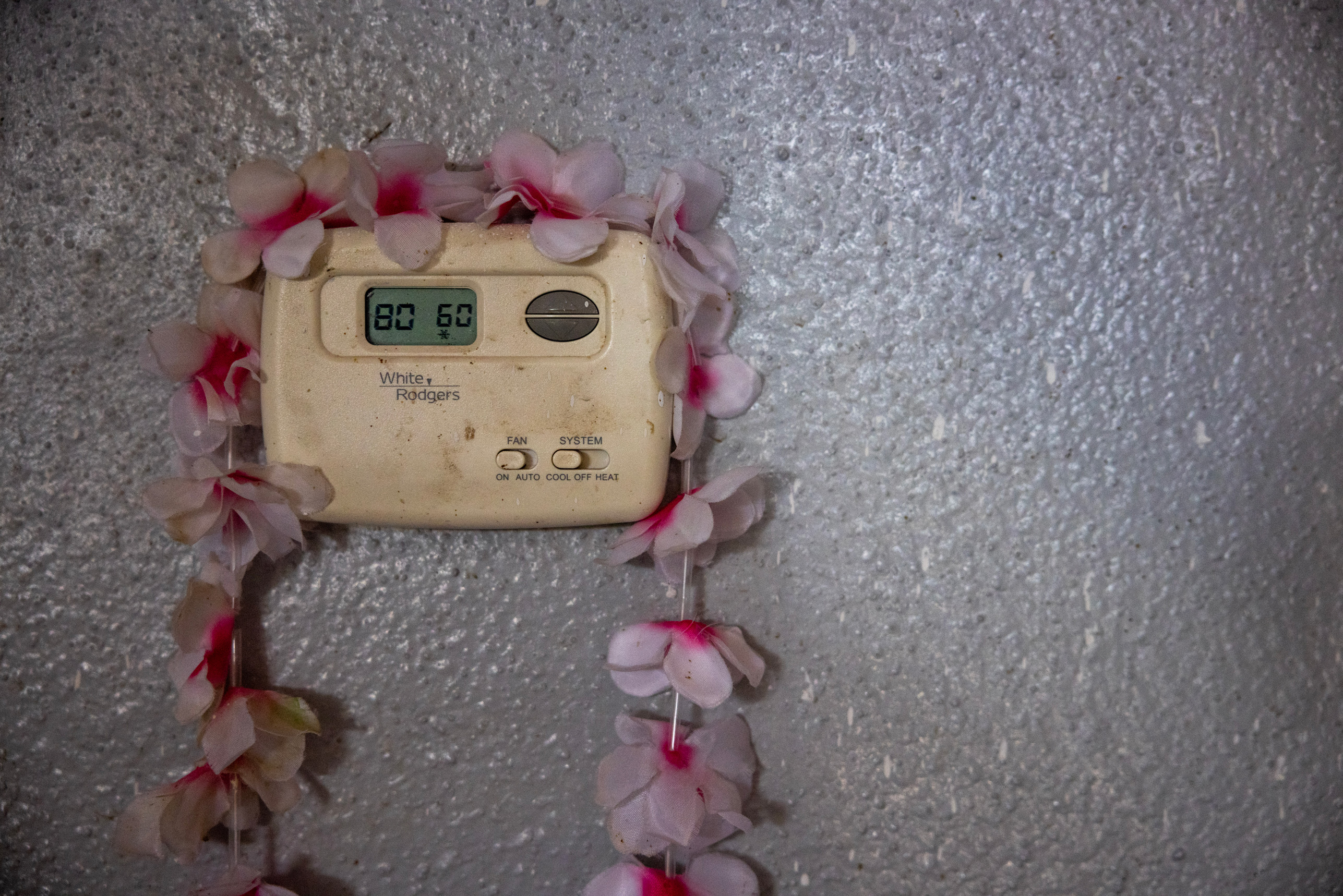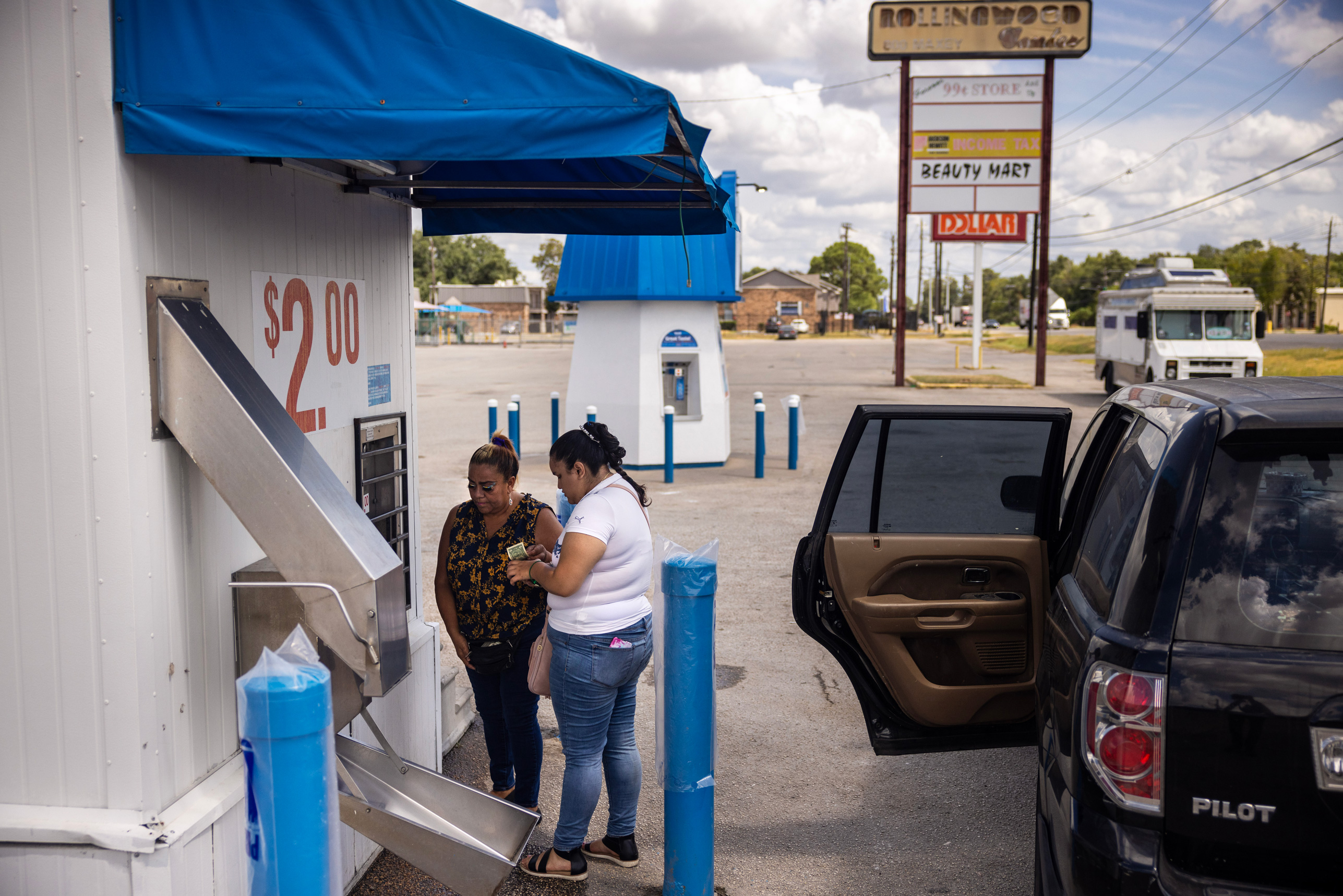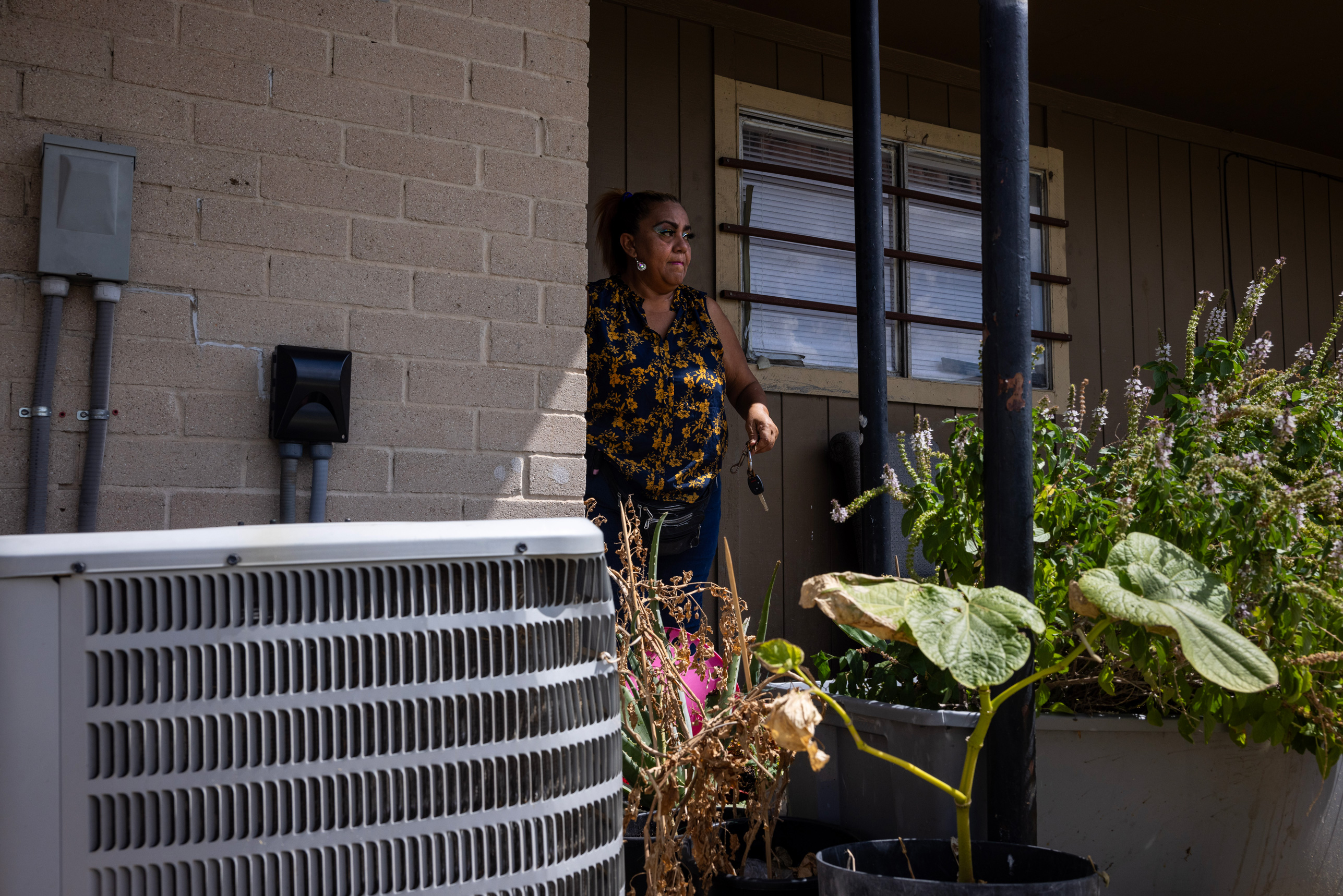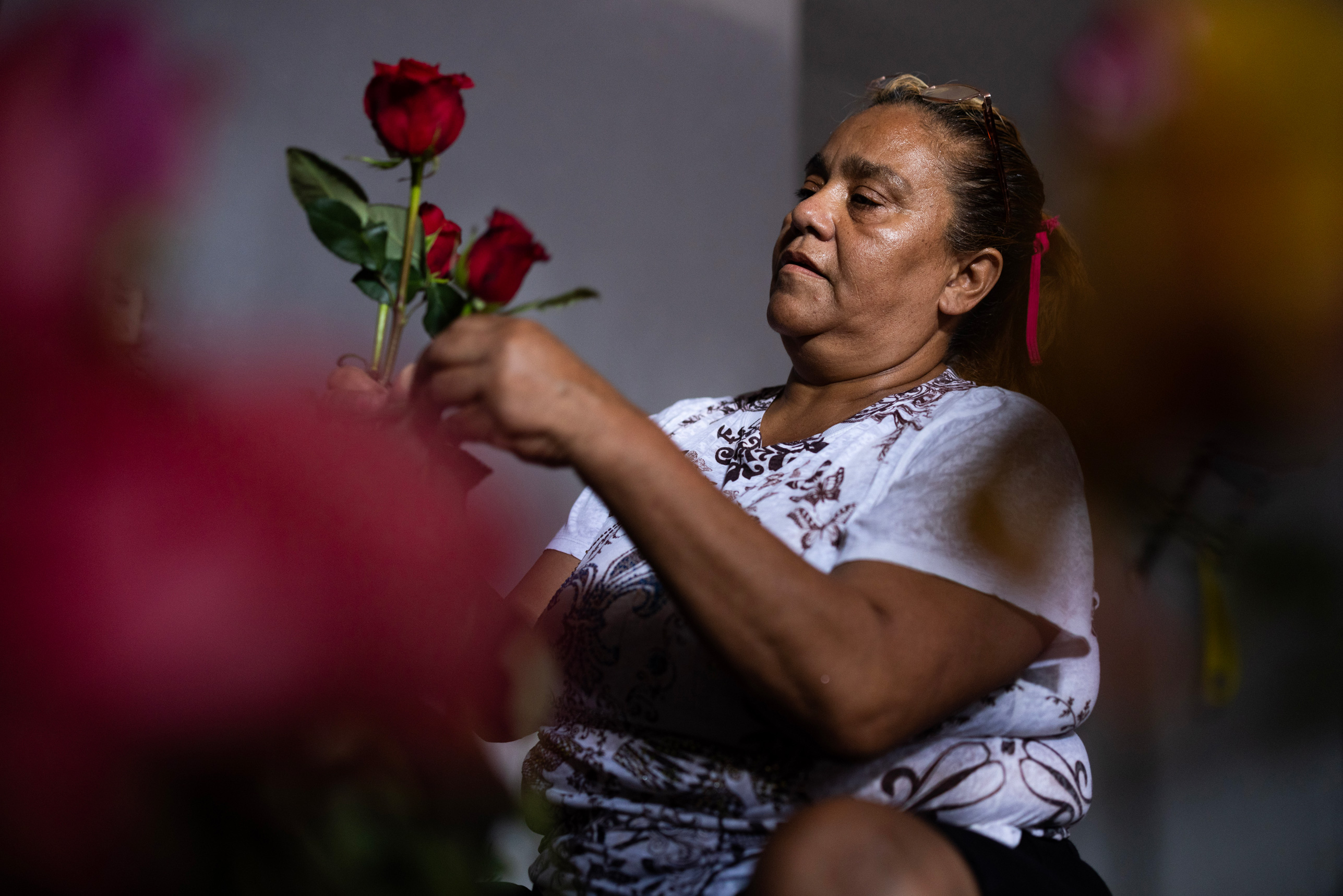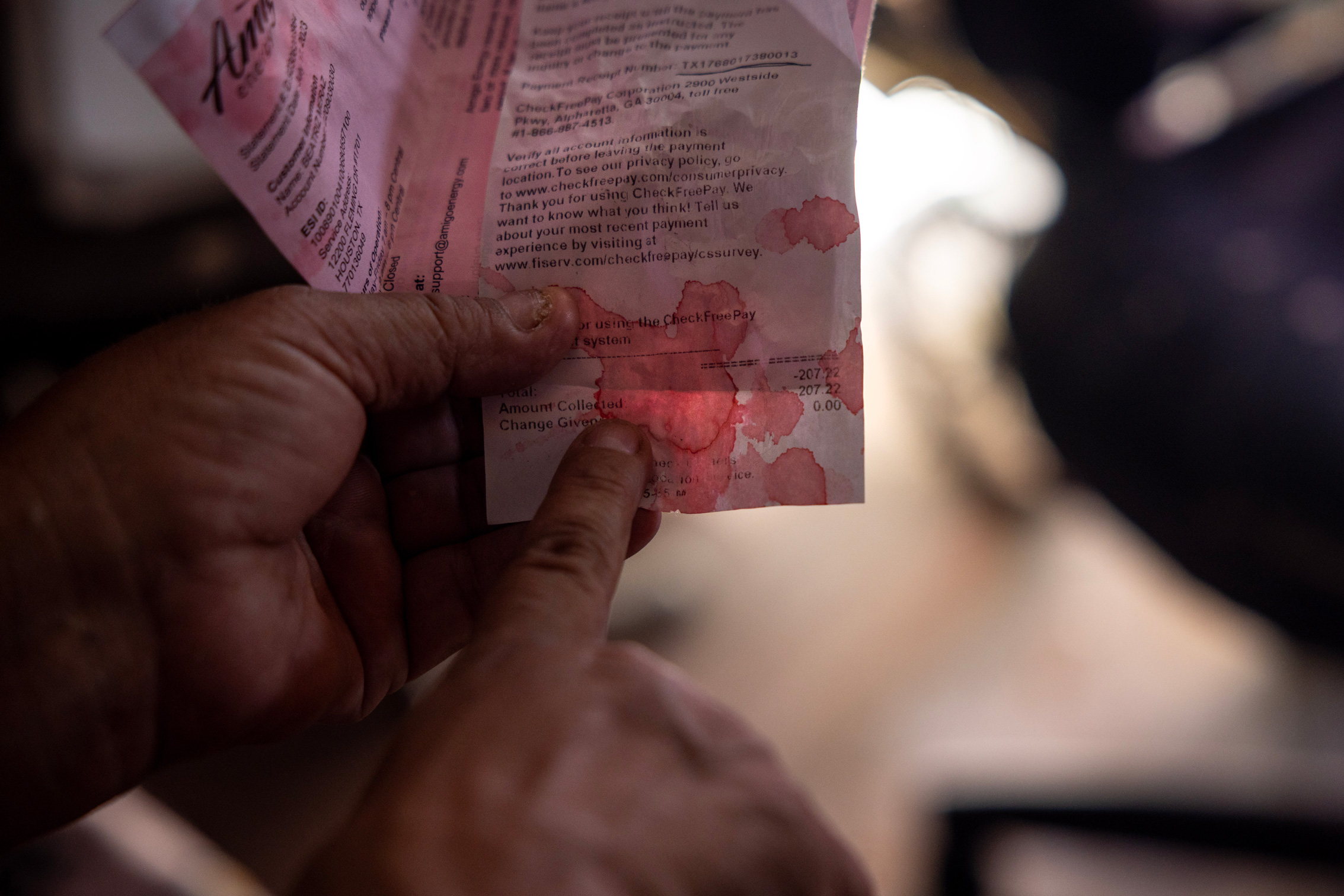|
Getting your Trinity Audio player ready...
|
At her chair in the middle of the living room, Meraz Vargaz, 58, is building bouquets of flowers to sell on the street and at a flea market on Airline Drive in north Houston. She will throw away the wilting flowers one at a time as she comes upon them, each drooping and dying from the heat, each a waste of time and money. But in the end, she does not have a lot of options. It’s 102 degrees in Houston and 81 degrees in her apartment – with a broken air-conditioning unit serving to do nothing but rattle away just above her head and run up the energy bill.
She loves mixing the colors together, the yellows and soft pinks and bright reds, and creating combinations wrapped up neatly and uniquely. She will work until about 40 bouquets are finished, or until she sways, exhausted and dizzy from the heat, and lays down by the oscillating fan in her bedroom.
Ever since Meraz Vargaz and her daughter, 19-year-old Rosa Maria Morales, moved into the Timber Ridge Apartments on the east side of Houston about two years ago, their apartment’s central air conditioning unit has not worked properly. Last week, as she prepared the flowers for sale, the unit’s display showed a set temperature of 60 degrees, but the apartment never got cooler than 80 degrees.
“When I cook, I keep having to go into the bedroom to get some air,” said Meraz Vargaz. “The landlords keep saying they will fix it and they never do anything about it.”
Houston is a severely unequal place when it comes to who feels the heat the worst, according to a report that Harris County Public Health published in 2021. And when it comes to air conditioning, Meraz Vargaz doesn’t have it the worst. Nearly 23,000 housing units in the Houston metro area do not have any air conditioning at all, neither central air nor window units, according to census data. But thousands more, like Meraz Vargaz and her daughter, have air conditioning, but it is broken or malfunctioning.
There is often not an easy solution available. Meraz Vargaz has done what she can: She’s covered the windows in reflective film and hung blankets over them to keep the sun out. She also has fans whirring in the living room and bedroom. Yet, in spite of an air conditioner that doesn’t work, the electric bill last month was $207 for her 600-square-foot apartment.
Houston is a town dotted by what scientists call “urban heat islands,” which are areas with less green space and more asphalt or surface cover, where temperatures can be several degrees hotter than other nearby neighborhoods at the same time. Those spots tend to be in some of Houston’s more vulnerable communities, such as Kashmere Gardens on the northeast side of town, or Denver Harbor on the southeast side.
At the same time, who has AC in their home, and whose AC is working, is also a measure that conforms to the contours of economic inequality. As a result, a stark line appears on the map between the east and west sides of town, highlighting the disproportionate impact of heat on the most vulnerable Houstonians, such as those who are disabled, lack health insurance or live in poorer communities.
The Extreme Heat Vulnerability Report lays plain the fact that the country’s fourth largest city is a place where those who are exposed to the highest levels of heat are also unable to obtain or afford functioning air conditioning.
But for the time being, Meraz Vargaz, like many other residents in Houston, is left in the heat. “It’s horrible,” she said in Spanish. “I can’t lower the air, so we just live in it.”
Heat and equity
Harris County Public Health analyzed 16 different indicators for heat vulnerability in the report, including: access to air conditioning, age, health insurance, poverty and race. The combined indicators were calculated to find which areas of Houston have the greatest vulnerability to high temperatures.
Residents on the eastern side of Harris County in neighborhoods such as Kashmere Gardens, Denver Harbor, Mayfair, Clinton Park and Pasadena were the most vulnerable to heat and also had the lowest levels of air conditioning access.
Wealthier neighborhoods such as the Heights, Bellaire and the Galleria area were the least vulnerable parts of town to heat, with the highest levels of air conditioning access.
“Heat is a health inequity, in that low-income communities and communities of color disproportionately live in areas of cities that have higher temperatures than other areas,” said Kevin Lanza, an assistant professor of environmental science at UTHealth Houston School of Public Health who researches heat and health inequity. “These are areas that were historically disinvested in, have less tree canopy and less vegetation,” he said, adding that the legacy of redlining, the historic discriminatory practice of refusing home or business loans to people in poorer areas, still holds true in many Texas cities.
As a result, many of the areas that are hottest are also less-resourced, lower-income communities of color. “As extreme heat events rise over time, we’re really seeing the disparities and vulnerabilities in these communities that don’t have access to AC,” said Kelly Sanders, an environmental engineering professor at The University of Southern California. “There are a lot of barriers for vulnerable communities to gain access to these important cooling systems, like ACs or cooling centers.”
Lack of regulations
Those vulnerabilities are intensified when someone does not own their home, as in the case of tenants like Meraz Vargaz. Instead, she depends on a landlord to keep her cool. In Texas, tenants have few protections when it comes to access to air conditioning.
In the city of Houston, landlords must provide a cooling system only if the property does not have window screens. If there are no screens, the landlord is required to keep the apartment or house at 20 degrees below the outside temperature.
“Houston’s ordinance about air conditioning definitely has some loopholes for landlords,” said Ben Martin, research director at Texas Housers, a nonprofit organization advocating for affordable and safe housing for lower-income residents. “If it’s 110 degrees outside in Houston, then the landlord could set the temperature to 90 degrees.”
That ordinance can leave residents to live with high temperatures all summer, and “that could still be considered an unsafe and unhealthy temperature for someone, especially for a senior or someone living with a disability,” Martin added.
At the Timber Ridge Apartments, where Meraz Vargaz lives, tenants have been working with the Texas Organizing Project to put pressure on the landlords. Mayor Sylvester Turner has also promised action.
The Timber Ridge Apartments property managers did not respond to Abdelraoufsinno’s request for comment. The Houston’s Mayor’s Office also did not respond to requests for comment on the ordinance.
In June, with funding from Reliant Energy and the Harris County Area Agency on Aging, the city of Houston gave out 350 window air conditioning units to residents who were elderly or disabled. The air conditioners were gone in a week.
At the state level, there are no specific regulations requiring landlords to provide air conditioning in rental properties. This year, state Rep. Sheryl Cole from Travis County, authored a house bill to require landlords to provide working air conditioners systems or units for their tenants and lower the repair time from seven days to five. While 10 other Democrat representatives sponsored the bill, including Rep. Shawn Thierry of Harris County, it did not make it to a hearing.
Tough choices
Although much of Houston is suffering from the summer’s heat, different people are suffering in different ways.
For example, the AC unit in Liz Villarreal’s apartment in the Denver Harbor neighborhood is working perfectly. However, she is living in heat because she can’t afford to cool her entire house.
If she were to try to cool her whole home, she wouldn’t be able to afford to also fill her car with gas, or buy the groceries she needs to take care of her 18-year-old grandson, who lives with her. As a result, Villarreal, 60, cooks their meals in the hot kitchen, which she leaves un-cooled, and eats her dinner in one of the bedrooms, the only rooms she keeps air conditioned.
This kind of economic pressure is common for many residents in Houston – both tenants and property owners, said Carmen Cavezza, climate justice community organizer for the Coalition for Environment, Equity and Resilience, a local environmental and public health organization.
“There are a lot of old, inefficient houses in Houston, houses that have very little insulation which either get really cold in the winter or really hot in the summer,” Cavezza said. “So the dilemma for residents is if they use their air conditioner, their bills will be really high. If they don’t, the house will be too hot.”
And some rental apartments cannot even accommodate all types of units, and must rely only on weaker, lower-voltage air conditioners to avoid electrical damage. That’s the bind that Carol Smith, a resident in Fifth Ward, finds herself in. She rents a home with a small, 110-volt air conditioner, which barely cools the home down – most AC units require over 200 volts.
“If I stand directly in front of the AC, I can cool off,” she said. “If I go anywhere else, it’s unlivable.”
But just as few seemed to pay attention to the Harris County map that revealed the inequalities in air conditioning in the Houston region, residents and advocates say they feel like local officials aren’t paying attention to their plight.
“If anyone isn't paying attention before, they need to be now because it's not getting any colder in Houston and we're seeing some extreme temperatures this summer and we're going to keep seeing them through our lifetime,” said Ben Martin of Texas Housers.
“This issue is only going to get worse and it's going to have huge impacts on the health and safety of the residents of our state.”


